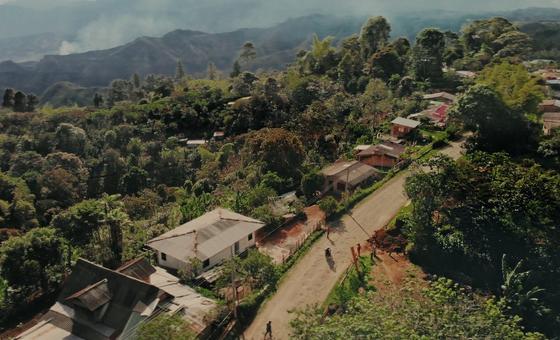The 2016 peace deal between the authorities and the FARC-EP militia group ended five decades of conflict, and the report is the first to cover verification of its chapters on comprehensive rural reform and ethnic issues, in line with a Security Council resolution adopted in January.
The report spans the period from late December to late March. Mr. Guterres highlighted progress made during this time, and commitment by the parties, noting that even in the midst of immense challenges, there were grounds for optimism.
Violence still occurring
However, he added that “the inescapable reality on the ground in Colombia today is that peacebuilding depends both on the full implementation of the Agreement and on the ability of the authorities to curb the expressions of violence that continue to occur.”
In this regard, the Secretary-General urgently called for de-escalation of the conflict and perseverance in the search for peace through dialogue.
He commended the delegations of the Government and the ELN rebel group for their constructive exchange during a second round of negotiations in Mexico, held last month.
Ceasefire hopes
“I am confident that we will soon see additional results as they address key agenda issues in the next round, including communities’ call for a ceasefire,” he said.
If carried out properly, the ceasefire would “have the potential to reduce violence and build confidence in nascent dialogue processes, while alleviating obstacles to the implementation of the Peace Agreement.”
Rural reform and ethnic issues
The report highlighted actions taken so far on rural reform, as well as commitment to overcome the historical inequalities that are among the causes of Colombia’s conflict.
Reference was made to the Government’s draft National Development Plan, which includes a large budget allocation for this first chapter of the Agreement, and specifications to allow more equitable and broader access to land by rural populations and those affected by the conflict.
Regarding the ethnic chapter, the report underlined the importance of its cross-cutting provisions to address historical demands of indigenous and Afro-Colombian communities. Attention was also focused on the challenges that these communities continue to face, including insecurity in some regions of the country.
Killings and fighting
The report further noted that despite the killings of six former FARC-EP combatants, the past quarter was among the least violent since the laying down of arms in 2017.
However, other forms of violence against former fighters continue, including threats, attempted killings, enforced disappearances and abductions.
The UN Mission also observed a reduction in killings and fighting between armed elements in rural areas of four regions – Caquetá, Meta, Putumayo and Norte de Santander – while also expressing concern over high levels of conflict-related violence in Cauca, Arauca, Chocó, Nariño and Valle del Cauca.
Women as peacebuilders
Meanwhile, gender inequalities persist, and the report referred to particular challenges faced by women, girls and LGBTI people that continue to hamper their effective participation in peacebuilding efforts.
The Secretary-General also recognized the leading role of Colombian women as peacebuilders and agents of justice and reconciliation.
“I am confident that their meaningful participation will be ensured so that their voices can continue to influence the ongoing discussions around peace and security. The United Nations is inspired by their example and stands by their side,” he said.
The full report will be presented to the Security Council by Carlos Ruiz Massieu, UN Special Representative in Colombia, on Thursday.

